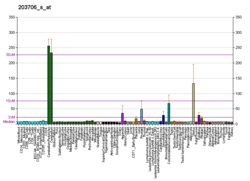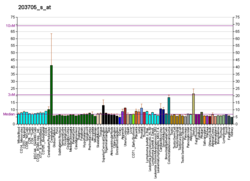Frizzled-7
| FZD7 | |||||||||||||||||||||||||||||||||||||||||||||||||||
|---|---|---|---|---|---|---|---|---|---|---|---|---|---|---|---|---|---|---|---|---|---|---|---|---|---|---|---|---|---|---|---|---|---|---|---|---|---|---|---|---|---|---|---|---|---|---|---|---|---|---|---|
| |||||||||||||||||||||||||||||||||||||||||||||||||||
| Identifiers | |||||||||||||||||||||||||||||||||||||||||||||||||||
| Aliases | FZD7, FzE3, frizzled class receptor 7 | ||||||||||||||||||||||||||||||||||||||||||||||||||
| External IDs | OMIM: 603410; MGI: 108570; HomoloGene: 20751; GeneCards: FZD7; OMA:FZD7 - orthologs | ||||||||||||||||||||||||||||||||||||||||||||||||||
| |||||||||||||||||||||||||||||||||||||||||||||||||||
| |||||||||||||||||||||||||||||||||||||||||||||||||||
| |||||||||||||||||||||||||||||||||||||||||||||||||||
| |||||||||||||||||||||||||||||||||||||||||||||||||||
| |||||||||||||||||||||||||||||||||||||||||||||||||||
| Wikidata | |||||||||||||||||||||||||||||||||||||||||||||||||||
| |||||||||||||||||||||||||||||||||||||||||||||||||||
Frizzled-7 (Fd-7) is a protein that in humans is encoded by the FZD7 gene.[5][6][7]
Members of the 'frizzled' gene family encode 7-transmembrane domain proteins that are receptors for Wnt signaling proteins. The FZD7 protein contains an N-terminal signal sequence, 10 cysteine residues typical of the cysteine-rich extracellular domain of Fz family members, 7 putative transmembrane domains, and an intracellular C-terminal tail with a PDZ domain-binding motif. FZD7 gene expression may downregulate APC function and enhance beta-catenin-mediated signals in poorly differentiated human esophageal carcinomas.[7]
Interactions
Fz-7 has been shown to interact with DLG4.[8]
References
- ^ a b c GRCh38: Ensembl release 89: ENSG00000155760 – Ensembl, May 2017
- ^ a b c GRCm38: Ensembl release 89: ENSMUSG00000041075 – Ensembl, May 2017
- ^ "Human PubMed Reference:". National Center for Biotechnology Information, U.S. National Library of Medicine.
- ^ "Mouse PubMed Reference:". National Center for Biotechnology Information, U.S. National Library of Medicine.
- ^ Tanaka S, Akiyoshi T, Mori M, Wands JR, Sugimachi K (September 1998). "A novel frizzled gene identified in human esophageal carcinoma mediates APC/beta-catenin signals". Proc Natl Acad Sci U S A. 95 (17): 10164–9. Bibcode:1998PNAS...9510164T. doi:10.1073/pnas.95.17.10164. PMC 21479. PMID 9707618.
- ^ Sagara N, Toda G, Hirai M, Terada M, Katoh M (December 1998). "Molecular cloning, differential expression, and chromosomal localization of human frizzled-1, frizzled-2, and frizzled-7". Biochem Biophys Res Commun. 252 (1): 117–22. doi:10.1006/bbrc.1998.9607. PMID 9813155.
- ^ a b "Entrez Gene: FZD7 frizzled homolog 7 (Drosophila)".
- ^ Hering, Heike; Sheng Morgan (June 2002). "Direct interaction of Frizzled-1, -2, -4, and -7 with PDZ domains of PSD-95". FEBS Lett. 521 (1–3). Netherlands: 185–9. doi:10.1016/S0014-5793(02)02831-4. ISSN 0014-5793. PMID 12067714. S2CID 39243103.
Further reading
- Finch PW, He X, Kelley MJ, et al. (1997). "Purification and molecular cloning of a secreted, Frizzled-related antagonist of Wnt action". Proc. Natl. Acad. Sci. U.S.A. 94 (13): 6770–5. Bibcode:1997PNAS...94.6770F. doi:10.1073/pnas.94.13.6770. PMC 21233. PMID 9192640.
- Hering H, Sheng M (2002). "Direct interaction of Frizzled-1, -2, -4, and -7 with PDZ domains of PSD-95". FEBS Lett. 521 (1–3): 185–9. doi:10.1016/S0014-5793(02)02831-4. PMID 12067714. S2CID 39243103.
- Strausberg RL, Feingold EA, Grouse LH, et al. (2003). "Generation and initial analysis of more than 15,000 full-length human and mouse cDNA sequences". Proc. Natl. Acad. Sci. U.S.A. 99 (26): 16899–903. Bibcode:2002PNAS...9916899M. doi:10.1073/pnas.242603899. PMC 139241. PMID 12477932.
- Yao R, Natsume Y, Noda T (2005). "MAGI-3 is involved in the regulation of the JNK signaling pathway as a scaffold protein for frizzled and Ltap". Oncogene. 23 (36): 6023–30. doi:10.1038/sj.onc.1207817. PMID 15195140.
- Omoto S, Hayashi T, Kitahara K, et al. (2004). "Autosomal dominant familial exudative vitreoretinopathy in two Japanese families with FZD4 mutations (H69Y and C181R)". Ophthalmic Genet. 25 (2): 81–90. doi:10.1080/13816810490514270. PMID 15370539. S2CID 32817238.
- Gerhard DS, Wagner L, Feingold EA, et al. (2004). "The status, quality, and expansion of the NIH full-length cDNA project: the Mammalian Gene Collection (MGC)". Genome Res. 14 (10B): 2121–7. doi:10.1101/gr.2596504. PMC 528928. PMID 15489334.
- Vincan E, Darcy PK, Smyth MJ, et al. (2005). "Frizzled-7 receptor ectodomain expression in a colon cancer cell line induces morphological change and attenuates tumor growth". Differentiation. 73 (4): 142–53. doi:10.1111/j.1432-0436.2005.00015.x. PMID 15901282.
- Rual JF, Venkatesan K, Hao T, et al. (2005). "Towards a proteome-scale map of the human protein-protein interaction network". Nature. 437 (7062): 1173–8. Bibcode:2005Natur.437.1173R. doi:10.1038/nature04209. PMID 16189514. S2CID 4427026.
- Lim J, Hao T, Shaw C, et al. (2006). "A protein-protein interaction network for human inherited ataxias and disorders of Purkinje cell degeneration". Cell. 125 (4): 801–14. doi:10.1016/j.cell.2006.03.032. PMID 16713569. S2CID 13709685.
- Vincan E, Darcy PK, Farrelly CA, et al. (2007). "Frizzled-7 dictates three-dimensional organization of colorectal cancer cell carcinoids". Oncogene. 26 (16): 2340–52. doi:10.1038/sj.onc.1210026. PMID 17016432.
- Struewing IT, Barnett CD, Zhang W, et al. (2007). "Frizzled-7 turnover at the plasma membrane is regulated by cell density and the Ca(2+) -dependent protease calpain-1". Exp. Cell Res. 313 (16): 3526–41. doi:10.1016/j.yexcr.2007.07.012. PMID 17716656.
External links
- "Frizzled Receptors: FZD7". IUPHAR Database of Receptors and Ion Channels. International Union of Basic and Clinical Pharmacology. Archived from the original on 2016-03-03. Retrieved 2008-12-04.
This article incorporates text from the United States National Library of Medicine, which is in the public domain.
- v
- t
- e
| |||||||||||||||||||||||||||||||
| |||||||
| |||||
Class F: Frizzled & Smoothened | |||||
|---|---|---|---|---|---|
| |||||
 | This transmembrane receptor-related article is a stub. You can help Wikipedia by expanding it. |
- v
- t
- e


















